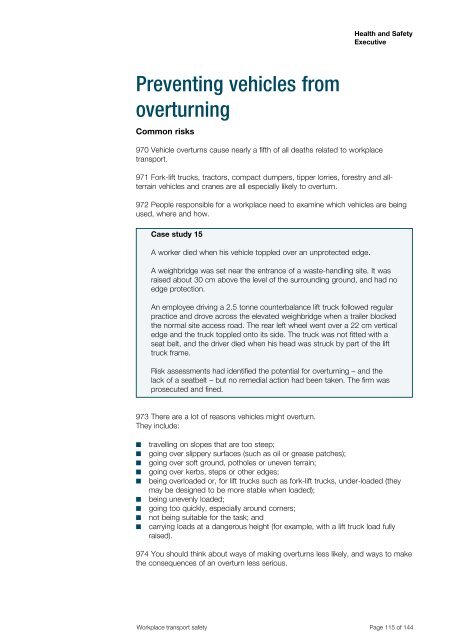Workplace transport safety An employers' guide - ARRI Lighting Rental
Workplace transport safety An employers' guide - ARRI Lighting Rental
Workplace transport safety An employers' guide - ARRI Lighting Rental
Create successful ePaper yourself
Turn your PDF publications into a flip-book with our unique Google optimized e-Paper software.
Preventing vehicles from<br />
overturning<br />
Common risks<br />
970 Vehicle overturns cause nearly a fifth of all deaths related to workplace<br />
<strong>transport</strong>.<br />
Health and Safety<br />
Executive<br />
971 Fork-lift trucks, tractors, compact dumpers, tipper lorries, forestry and allterrain<br />
vehicles and cranes are all especially likely to overturn.<br />
972 People responsible for a workplace need to examine which vehicles are being<br />
used, where and how.<br />
Case study 15<br />
A worker died when his vehicle toppled over an unprotected edge.<br />
A weighbridge was set near the entrance of a waste-handling site. It was<br />
raised about 30 cm above the level of the surrounding ground, and had no<br />
edge protection.<br />
<strong>An</strong> employee driving a 2.5 tonne counterbalance lift truck followed regular<br />
practice and drove across the elevated weighbridge when a trailer blocked<br />
the normal site access road. The rear left wheel went over a 22 cm vertical<br />
edge and the truck toppled onto its side. The truck was not fitted with a<br />
seat belt, and the driver died when his head was struck by part of the lift<br />
truck frame.<br />
Risk assessments had identified the potential for overturning – and the<br />
lack of a seatbelt – but no remedial action had been taken. The firm was<br />
prosecuted and fined.<br />
973 There are a lot of reasons vehicles might overturn.<br />
They include:<br />
n travelling on slopes that are too steep;<br />
n going over slippery surfaces (such as oil or grease patches);<br />
n going over soft ground, potholes or uneven terrain;<br />
n going over kerbs, steps or other edges;<br />
n being overloaded or, for lift trucks such as fork-lift trucks, under-loaded (they<br />
may be designed to be more stable when loaded);<br />
n being unevenly loaded;<br />
n going too quickly, especially around corners;<br />
n not being suitable for the task; and<br />
n carrying loads at a dangerous height (for example, with a lift truck load fully<br />
raised).<br />
974 You should think about ways of making overturns less likely, and ways to make<br />
the consequences of an overturn less serious.<br />
<strong>Workplace</strong> <strong>transport</strong> <strong>safety</strong> Page 115 of 144
















